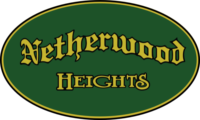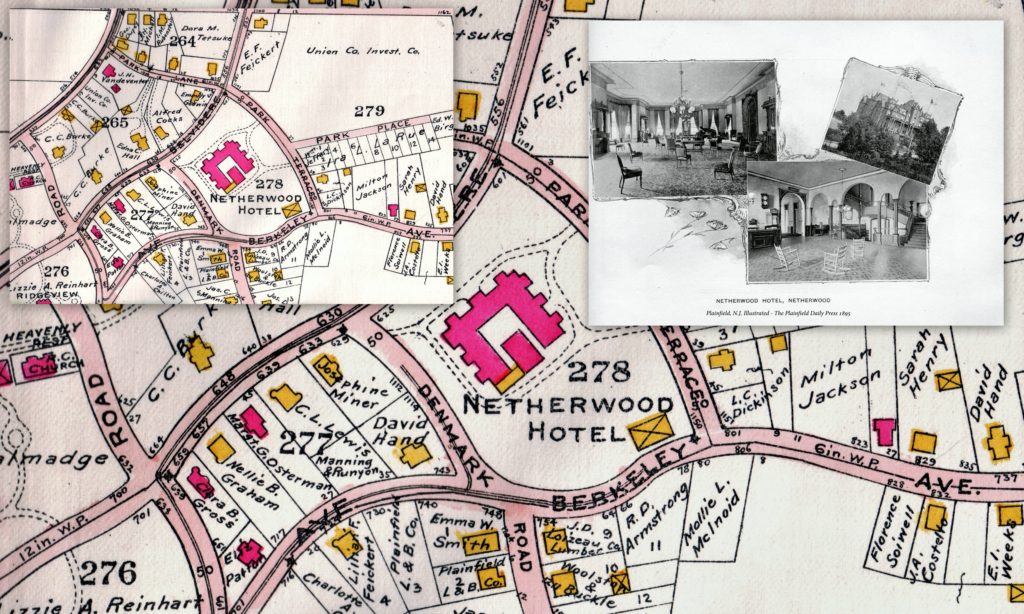Mission Statement
Netherwood Heights Neighbors (NHN) is a 501(c)(3) local organization whose mission is to enhance and preserve the quality of life within the Netherwood Heights neighborhood. NHN works to create opportunities through education and charitable endeavors, and by supporting activities that encourage a sense of community, that address citizen safety, and that promote awareness of issues pertaining to the neighborhood which has a growing and diverse constituency.
The NHN elects a board and holds regular resident meetings to discuss items including but not limited to the following:
- Social Events
- Neighborhood Safety
- City of Plainfield Topics of Interest to Our Neighbors
- Partnership with City Government and other local Organizations to Advance Shared Projects
- Netherwood Heights Historic District and Preserving the Character of the Neighborhood
- Charitable Projects and Fund Raising
- Suggestions and Improvements
Click here to read the NHN Charter and Bylaws.
History
The Netherwood Hotel
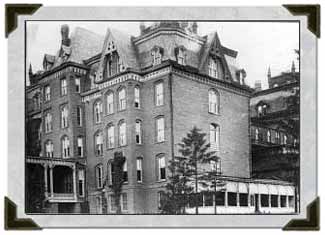 Netherwood Heights is named for the Netherwood Hotel which stood at what are now the blocks bordered by Denmark Road, Park Terrace, Belvidere Avenue, and Berkeley Avenue. (see figs. 1 and 2). The hotel opened in June 1878 and was at one time a grand resort with an extensive social calendar and famous guests. A series of owners tried to make use of the property, but the hotel was demolished in October 1917.
Netherwood Heights is named for the Netherwood Hotel which stood at what are now the blocks bordered by Denmark Road, Park Terrace, Belvidere Avenue, and Berkeley Avenue. (see figs. 1 and 2). The hotel opened in June 1878 and was at one time a grand resort with an extensive social calendar and famous guests. A series of owners tried to make use of the property, but the hotel was demolished in October 1917.
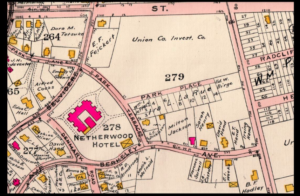 Although the grand undertaking never seemed to make much money, it left a vital neighborhood as its legacy. Original retaining walls of the hotel’s property still stand in front of 601 Belvidere and 755 Berkeley Avenue. A horse path to the hotel is located behind 701 Belvidere Avenue and the carriage house on 653 Ravine survives as a single family home.
Although the grand undertaking never seemed to make much money, it left a vital neighborhood as its legacy. Original retaining walls of the hotel’s property still stand in front of 601 Belvidere and 755 Berkeley Avenue. A horse path to the hotel is located behind 701 Belvidere Avenue and the carriage house on 653 Ravine survives as a single family home.
Netherwood Heights Historic District
The Netherwood Heights Historic District was designated a historic district by the City of Plainfield in 1988. Ninety-nine homes are located in the District (fig.3). Many of the homes date from the 1920’s as they were built after the demise of the Netherwood Hotel. Key to the location of the Netherwood Hotel and the Historic District was the expansion of the Central Railroad of New Jersey (now NJ Transit).
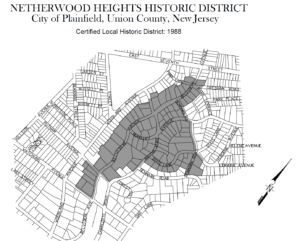 The Netherwood Station was first established as a station stop in 1874. The original station burned down in 1892, but the current building designed in the Richardson Romanesque-Queen Anne style dates to 1893. It was closed to the public in 1981 and the exterior was restored in 1998.
The Netherwood Station was first established as a station stop in 1874. The original station burned down in 1892, but the current building designed in the Richardson Romanesque-Queen Anne style dates to 1893. It was closed to the public in 1981 and the exterior was restored in 1998.
The Netherwood Heights Neighborhood
The geographic boundaries of the Netherwood Heights Neighborhood are Belvidere Avenue (from East Seventh Street to Watchung Avenue), Park Lane, Park Terrace, Berkeley Avenue, Ravine Road, Charlotte Road (from Woodland Avenue to Ravine Road), Denmark Road, Dixie Lane, Gresham Road, Osborne Avenue, and Lorraine Avenue (from Osborne Avenue to Denmark Road). The oldest homes date from the 1880’s, and the Netherwood Heights Historic District is located withing this area.
Examples of the stately homes in the neighborhood can be seen along Belvidere Avenue. Two such homes were owned by Samuel Rushmore, an inventor of the automobile self-starter and hydraulic brake systems as well as improvement to automobile headlights, searchlights for ships and many other inventions. The first home at 600 Belvidere Avenue (built in 1905) is known as the Rushmore-Coffin House because a coffin was placed on the roof of the porch to protest alleged corruption at the time. The second home at 777 Belvidere Avenue still has a bowling alley and tunnel to a secondary house. Along Belvidere Avenue from 601 to 621 are four Tudor Revival homes built on the site of the Netherwood Hotel in the 1920’s and 1930’s. The home at 556 Belvidere was home for many years to H. K. Tetsuka, son of a famous Japanese potter, who joined Morimura Brothers of NY who first imported Noritake China into the US in 1914. The history of the many interesting homes in the neighborhood are part of its charm and help define the historic character of the neighborhood.
Updated July 2021
